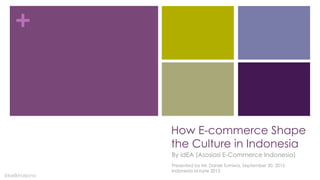How E-Commerce Shape the Future of Indonesia
- 1. + How E-commerce Shape the Culture in Indonesia By idEA (Asosiasi E-Commerce Indonesia) Presented by Mr. Daniel Tumiwa, September 30, 2015 Indonesia id-byte 2015 @kelikharjono
- 2. +Indonesia is among the biggest e-commerce market in SEA Market Size ($ billion, 2013) Vietnam ?? 91 million inhabitants ?? 40 million internet users ?? 24 million digital buyers Thailand ?? 65 million inhabitants ?? 19 million internet users ?? 14 million digital buyers Malaysia ?? 30 million inhabitants ?? 20 million internet users ?? 16 million digital buyers Indonesia ?? 248 million inhabitants ?? 39 million internet users ?? 5 million digital buyers Singapore ?? 5.5 million inhabitants ?? 4 million internet users ?? 3.2 million digital buyers The Philippines ?? 97 million inhabitants ?? 36 million internet users ?? 25 million digital buyers 2 Note : Market Size figures are rounded Source : International Monetary Fund $0.8 $0.9 $1.3 $1.3 $1.7 $1.0 $7.0ASEAN 6 21.5%26.4% 53.3% 58.2% 25.8% 2%
- 3. +But it is still way smaller than these e-commerce giants of the world Market Size ($ billion, 2013, % of global total) EU 5 ?? 317 million inhabitants ?? 247 million internet users ?? 180 million digital buyers Japan ?? 117 million inhabitants ?? 110 million internet users ?? 86 million digital buyers United States ?? 320 million inhabitants ?? 269 million internet users ?? 197 million digital buyers China ?? 1,368 million inhabitants ?? 626 million internet users ?? 309 million digital buyers ASEAN 6 ?? 537 million inhabitants ?? 158 million internet users ?? 87 million digital buyers 3 Note : Market Size figures are rounded Source : International Monetary Fund EU 5 includes The European UnionĪ»s Five Largest Economies : Germany, France, The UK, Italy, Spain $230 19% $119 10% $395 32% $181 15% $7 0.6% World $1,221 Rest of the World $289 23.4%
- 4. +The growth rate of our income per capita is far higher than the global average 4 2% 4.10% 4.60% 4.10% 5.70% 6.30% 1.50% 2.70% 2.10% 1.40% 3.20% 2.90% 1.20% 2.30% 1.30% 0.80% 2.00% 1.50% Global average Indonesia Thailand The Philippines Malaysia Singapore 2009-14 2014-19 2019-24 Note : Source : International Monetary Fund
- 5. +Indonesia economic growth will be fueled by consumer spending as the middle class continue to rise 5 By 2020 the mass-consuming class* will increase to 53 million households *Mass-consuming class is defined as those households with annual disposable income between USD5-30k per annum At market exchange rates and 2010 constant price Source : Accenture; Oxford Economics 2010 2020 US$, 000s 50+ 30-50 15-30 5-15 0-5 22% 65% By 2020, 65% of IndonesiaĪ»s households are forecast to be in the US$5-15 disposable income band and 22% in the US$15-30 band
- 6. +Indonesia is urbanizing at a rapid clip. By 2020, Indonesia will be dominated by urban dwellers 6 Source : Euromonitor, Ī░Indonesia in 2030: The Future DemographicĪ▒, August 2010 0 50 100 150 200 250 300 2000 2005 2010 2015 2020 Urban RuralTotal Population, In Million 42% 46% 50% 54% 57%
- 7. +Sumatra and Sulawesi are the next regions of urban growth 7 Source : Euromonitor, Ī░Indonesia in 2030: The Future DemographicĪ▒, August 2010 Total Population, In Million Top 10 biggest cities by population size in 2010 and prediction for 2020 Sumatra Kalimantan Jawa Sulawesi Jakarta Surabaya Bandung Bekasi Medan Tangerang Depok Semarang Palembang Makassar 2010 2020
- 8. +In compare to other countries, majority of population in Indonesia are still purchasing offline, but thatĪ»s about to change 8 Source : Frost & Sullivan, A.T. Kearney Analysis Percent of retail sales made online (2014, % of total sales) 7.80% 7.20% 5.80% 4.50% Europe China USA Singapore Malaysia Thailand The Philippines Indonesia Vietnam Around or below 1%
- 9. +Many Indonesian are still trapped in these misconception 9 Perception Vs. Fact What they think/ want The reality IĪ»d like to touch/ try the goods before buying them (41%) Return policies are being offered IĪ»m not clear on warranty (38%) Warranty guidelines are mostly clear I do not have a credit card (35%) Multiple payment options: credit card, debit card, bank transfer, cash on delivery, rekber
- 10. +By 2017, we could be the biggest e-commerce market in SEA 10 Source : eMarketers; AT Kearney Analysis Note: ASEAN 6 includes Indonesia, Malaysia, the Philippines, Singapore, Thailand, Vietnam. EU 5 includes the EuropeanĪ»s largest economies: Germany, France, the UK, Italy, and Spain 1.30 1.30 1.00 1.70 0.90 0.80 Indonesia Malaysia The Philippines Singapore Thailand Vietnam 25.00% 25.00% 11.00% 10.00% 6.00% China Asean 6 United States EU 5 Japan 25-30 10-15 8-12 7-10 12-15 5-7 Market Size ($ Billion) Estimated e-commerce growth rate (2013-2017)
- 11. +If we do it the right way, we could unleash Indonesia and SEA as the next e-commerce super power 11 Source : AT Kearney Analysis 2000 2005 2010 2015
- 12. +The e-commerce boom will also impact financial industries, as people opt for more convenience transaction method 12 COD ATM Transfer Alternative Trx GNNT Society Less Cash Society 2013 62% 2014 25% 2013 66% 2014 41% 2013 10% 2014 12% ?? Internet Banking ?? Rekber ?? SMS/Mobile Banking ?? Emoney ?? Debit Card
- 13. +The GOAL 13
- 14. + 14














